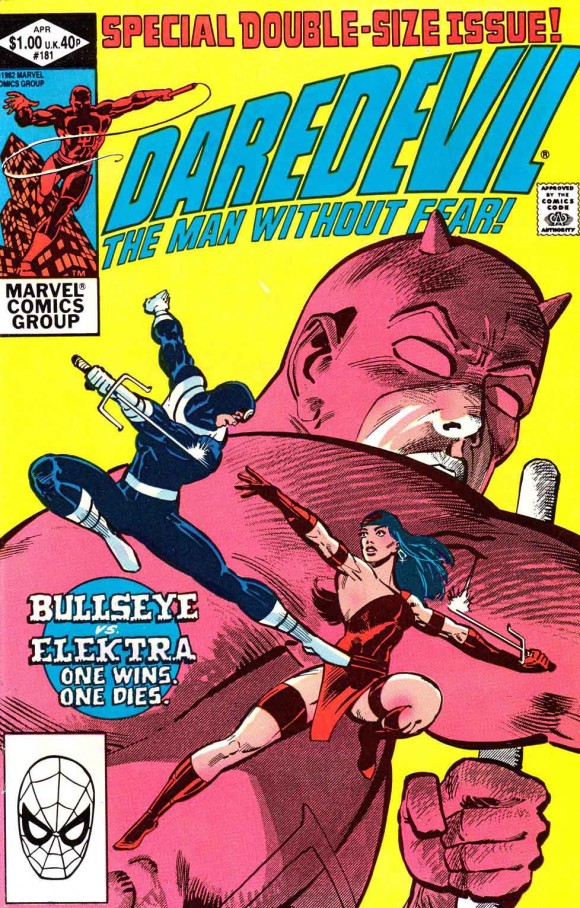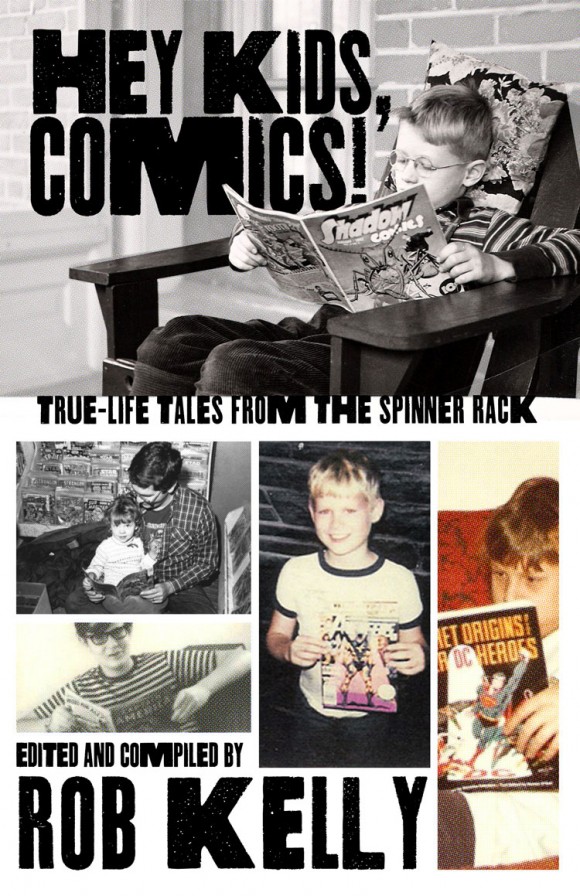Every other Friday, Rob Kelly is serializing his book “Hey Kids, Comics!: True-Life Tales From The Spinner Rack,” here at 13th Dimensi0n. Today, we finish up the chapter by IDW’s Chris Ryall. Missed the first part? No worries. It’s here.:
I flipped the comic over and saw this scratchy image of Daredevil set against a scratchy cityscape. This was the next big thing? Lots of scratchy lines and an unknown little “FM” scratched into the bottom corner of the art? I was a Marvel zombie through and through at that point, so I was inclined to go with whatever Marvel book the retailer stuck in my hand. But this? I don’t know, where was the polished sheen like, say, Bob Layton’s Iron Man or even the Michael Golden art on the lead story of this very issue of Fanfare? Dark, messy art is the way of the future? Not sure I wanted to be a part of that future. But I was a collector, and I was 12 – I was feeling my burgeoning pre-adulthood beckoning, and I thought maybe I was up for the challenge.
I learned that this Daredevil artist’s name was Frank Miller. I decided to try an issue of Daredevil and see if my retailer had totally lost it. That happened to be the month issue 181 was released. You know the one—Bullseye and Elektra squaring off with a big image of DD in the background and the lines “One Lives. One Dies” on the cover. By the time Bullseye lacerated Elektra’s throat with a playing card in the first half of that issue, I knew this was a comic like none I’d read before. I was 12, and I was stepping into a broader, darker world. And I welcomed it.
That year, I held hands with a girl at sixth-grade camp, but my discovery of Daredevil still stands out in my mind over all else. I have no idea what I got for my birthday that year. I have no idea what I unwrapped under the Christmas tree. But I’ll never forget (or forgive) Bullseye for running Elektra through with her own sai. Years passed. Characters lived and died (and, even then, were re-born. But the ones that weren’t, like Guardian, who went up in flames over a freak accident in Alpha Flight 12, whew, those left a mark on impressionable young me).
Age sixteen meant getting my driver’s license, which was possibly even more freeing to me than others my age, since it meant I could drive myself to the comic shop every week. I could spend more time poring over the racks, but even more, I could drive myself to a real job so I could finally afford to try new titles. My previous paperboy’s salary didn’t do much for my collecting, especially once comics hiked above the thirty-five-cent range. And those Frank Miller Daredevil back issues were even then a costly thing.
I turned sixteen during what is considered the greatest year in comics’ history – the glorious and revolutionary 1985-1986. Everyone knows how that year played out – Frank Miller dominated the scene with things like Daredevil: Born Again, Batman: Year One and The Dark Knight Returns; Alan Moore dropped the greatest comic-book series of all time on the world; John Byrne was lighting up the world on my beloved Fantastic Four; X-Men stayed dominant, even without earlier favorites like Byrne or Paul Smith drawing them; and DC was rebooting their universe post-Crisis with great creators like George Perez, J.M. DeMatteis and Kevin Maguire, Keith Giffen, Byrne, and so many others. Indie books from places like First Comics were a steady part of my diet then, too, and having my own wheels allowed me access to all of these worlds and creators. The covers to those issues scroll through my memory like yearbook photos of old friends. I might’ve struck out at the Sadie Hawkins dance that year, but I was scoring weekly at the comic store.
I can mark the time I got a new truck, a 1991 Chevy pick-up, not because I remember the bland model too clearly, but rather because I remember putting bags of comics that included the relaunched Chris Claremont/Jim Lee X-Men behind the bench seat. Those issues came out in 1991, so that must’ve been the year of my truck. See how it works? I can back out world events and my personal history just by remembering what comics mattered to then. I hid comics in my truck, see, because my roommates at the time weren’t comic fans and I tended to keep my hobby/passion a secret and… well, the specifics of the rationale for stashing my weekly scores behind my seat aren’t important, just that I can distinctly remember many of the exact comic covers that resided in said truck.
As happens when real life and real responsibilities start to intrude on leisure time, collecting and hobbies start to take a back seat to those things. For at least a number of years, time started to slip back into “real” calendar time, less marked by specific comic-book covers than by jobs, personal-life events, and the usual ways people mark the passing of time. And as more and more distractions, as well as more and more entertainment options, became regular parts of my days, comics didn’t take on the same all-consuming prominence that they did when I was a teen. But that’s true of anything—movies, music, all the things that mean something to you as you’re forming the adult you’ll eventually become, those are the things that create echoes that ripple our entire lives. And for me, nothing more than those comics.
Luckily, I’ve now spent close to the entire last decade working in the comics business, so not only have I once again been living on comic-book time, but in that time, I’ve created a number of comics that have allowed me to mark time through those covers all over again. And this time, if any of the covers I’ve been associated have help another other fan start tracking their own timeline through those issues, even better. I hope that’s the case—just as past creators did for me, it’d be great for me to think that my comics might help keep the comic-book clockwork going for others. It’s a much more entertaining way to track time than looking at a calendar.
—
Rob Kelly is a writer, illustrator, and comics historian. He is the creator and EIC of the world-famous (no, really!) Aquaman Shrine blog, which just celebrated its 7th anniversary. Some of his other online work includes TreasuryComics.com., JLASatellite.blogspot.com, and HeyKidsComix.Blogspot.com. In the print world, he has written articles for BACK ISSUE! and COMIC BOOK CREATOR.
Chris Ryall is the Chief Creative Officer and Editor-in-Chief of IDW Publishing, a San Diego-based comic book and graphic novel publisher. He is also an Eagle- and Eisner Award-nominated comic book writer/editor, co-creator of Zombies vs. Robots, Groom Lake, The Hollows, and The Colonized, and is the co-author of a prose book about comics, Comic Books 101. Chris lives in San Diego with his wife and daughter. “Four-Color Timelines” © 2013 Chris Ryall
“Hey Kids, Comics!: True-Life Tales From The Spinner Rack,” can be purchased on Amazon, Etsy, or Create Space.
“Four-Color Timelines” © 2013 Chris Ryall



